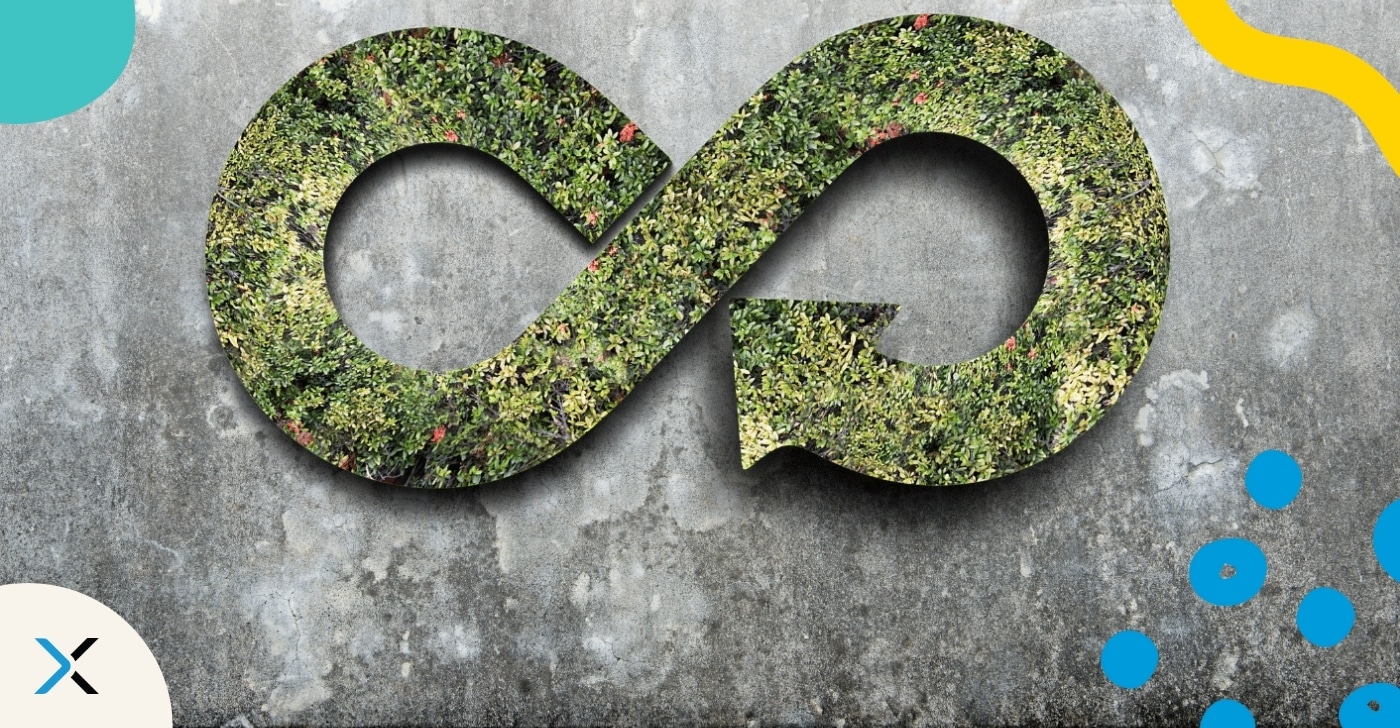What’s a Content Supply Chain & How Can It Become a Lifecycle?

It’s typical to think about supply chains in the context of industries like manufacturing or technology. But have you ever considered that your content creation process is also a supply chain?
What’s a content supply chain?
A content supply chain is a systematic approach to managing the entire lifecycle of content. It includes the process of planning, creating, editing, approving, delivering, and maintaining enterprise content.
The content supply chain includes managing a variety of stakeholders from different deparments and teams, as well as different content types. And make no bones about it, this is tricky. When you add in new generative AI technologies and the demand for faster, more controlled content production, it’s challenging. That being said, most companies don’t have the right content guardrails in place to safeguard their content supply chain against poor quality content.
Ivestopedia provides a thorough explanation of what a supply chain is and does:
“A supply chain is a network of companies and people that are involved in the production and delivery of a product or service. […] The functions of a supply chain include product development, marketing, operations, distribution, finance, and customer service.”
There’re multiple steps to take until a product finally reaches the end customer. The same is true for content: “A content supply chain treats content as a utility — where content is electricity and the technology is the grid.”
Limitations of a content supply chain
The content supply chain is a process and as with any enterprise process, it’s susceptible to inefficiencies. The content supply chain is often limited by it’s lack of visibility into each of the phases of content creation leading to compliance issues. This will be further exacerbated by generative AI being another writer in the content supply chain.
Content creation, editing, quality control, and distribution processes are time-consuming. If those phases are spread across different teams they can also be disjointed, leading to inefficiencies. With the average enterprise having limited visibility into the content lifecycle, it’s challenging to track the status and progress of content. Compliance issues, such as meeting regulatory standards and ensuring content consistency, can also pose significant challenges within the content supply chain.
Content governance software addresses these limitations by streamlining content creation and distribution processes, providing real-time visibility into the content lifecycle, Not only does this ensure compliance with regulations and standards, it facilitates collaboration among stakeholders. Content governance helps organizations manage and control their content more effectively, leading to improved quality, consistency, and compliance throughout the content supply chain.
The difference between the content supply chain and the content lifecycle
The content supply chain and the content lifecycle are two distinct concepts in content management. The content supply chain refers to the end-to-end process of creating, managing, and distributing content, involving multiple stages and stakeholders. On the other hand, the content lifecycle focuses on the stages that content goes through from creation to disposal or archiving. Understanding the differences between these two concepts is crucial for effective content management.
However, just because they are two different concepts doesn’t mean they aren’t impacted by each other. Enterprises that use content governance software in their content supply chain see an enhanced lifecycle for their content. Content governance aligns your writing with your brand standards, which improves content quality and consistency. All of which means that your content stays relevant for longer.
But for now, let’s focus on the concept of the content supply chain. Think about our blog on meaningful content, where we introduced the fast fashion metaphor. Sustainable fashion, unlike fast fashion, emphasizes the concept of reuse in more than one way. Which has led us to think of a lifecycle instead of a supply chain.
We see evidence of this lifecycle when we compare fast fashion production with sustainable fashion production. In the table below, we contrast the two, based on an infographic by GoodOnYou.
An example: fast fashion and sustainable fashion processes
Phases until clothes are sold:
| Phases | Typical fast fashion processes | Sustainable processes |
|---|---|---|
| Design | Fast fashion designers copy runway looks. | – Sustainable fashion designers lean toward long-lasting trends. – Sustainable fashion is often more casual and evergreen than fast fashion. |
| Producing materials | Often, low-quality materials like polyester are used. | – More natural fibers are used. – Sustainable fashion often follows higher textile standards. – Sometimes, reused fabrics are used. – Sometimes, fabric production uses less water than normal fabric production does. |
| Producing clothes | “Poor working conditions in some factories and sweatshops.” | – Often, there are better working conditions. – Some brands are even fair-trade. |
| Distribution and retail | “Widespread transportation of clothes and textiles leads to increased pollution.” | A few brands focus on regionality. |
Phases after clothes are sold:
| Phases | Typical fast-fashion processes | Sustainable fashion processes |
|---|---|---|
| Reaching customers | “Fast fashion manufacturer changes its collection every four weeks” – so customers are likely to buy new clothing very often to keep the pace. | Collections typically change seasonally and there are evergreen items. |
| Worn by customer | “35% of all microplastics — very small pieces of plastic that never biodegrade — in the ocean came from the laundering of synthetic textiles like polyester.” | The less microfiber in clothing, the less pollution happens while laundering. |
| Gets dumped | “Globally, an estimated 92 million tonnes of textile waste is created each year.” | Slow fashion elongates the time clothing is worn, so less clothing is dumped. |
| Circularity: is reworn | Typically, clothes aren’t reworn. | Often, sustainable clothing is slow fashion that lasts longer, so more than one person can wear it. |
| Circularity: is reused | Typically, clothes aren’t reused. | There are brands that upcycle materials. |
| Circularity: is recycled | “13% going to material recovery” (UK). |
The concept of sustainable production includes these sustainable fashion supply chains. And this concept is easily applicable to content! The magical term is “content lifecycle!” Instead of a process with a defined beginning and end, a lifecycle repeats. After it’s reached its audience, the impact and performance of digital content tells content experts what to do next.
Your strategy to implement a content lifecycle
Instead of crafting new content, creative teams can also refine the content they already have by adapting it to another audience, reusing good content, and drawing conclusions for the future. The circle closes.
Pre-publication and publication phase:
| Phases | Typical enterprise content workflows | Recommended content workflows |
|---|---|---|
| Concept | – Content creators copy other’s ideas. – Content creators react to new trends. – There’s a tendency to write what’s on an individual writer’s mind rather than following a strategy. | – Implement a strategy and a content plan. – Define your target audience. – Find out your target audience’s demand. – Identity relevant topics. – Choose the right channels to meet your audience. – Cover different funnel stages. |
| Choosing asset type | Choose fast content asset types like social media postings. | – Decide for a mixture of asset types for a rich customer experience. – Always consider what your audience is likely to read. |
| Content creation | – External writers and fluctuating teams create content. – There’s no content governance. – Insufficient content review may result in poor language quality. | – Focus on your content goals. – Use content governance to make sure you reach your goals. – Use AI writing assistance to align all writers to goals. – Produce high-quality content. |
| Content distribution | Marketers prefer multichannel (and typically the more, the better). | – Focus on where to meet your typical audience. – Distribute content where it’s relevant to its audience. – Besides active content distribution, focus on findability to make sure people find it. – Consider moving from multichannel to omnichannel. |
| Reaching customers | – Content is often maximized on clicks. – Content creators use fancy headlines to draw attention. – Sometimes, headlines and content aren’t in line. | – Content should be relevant for your audience. – It should fulfill what the headline promises. |
Post-publication phase:
| Phases | Typical enterprise content workflows | Recommended content workflows |
|---|---|---|
| End of consumption | High bounce rates and low time on page indicate a poor content experience. For instance, your visitors either find content irrelevant or leave because of low-quality content. They quit with the risk of not coming back. | – Focus on low bounce rates and high time on page, as this implies relevance and interest. – Never forget that high-quality content is essential to keep people interested and positive towards your content and your enterprise. |
| Long-lasting content impact | Typical enterprise content isn’t optimized for long-lasting content impact. | Reach long-lasting content impact: – Make people remember your content by being relevant. – Aim at making them come back to your website by delivering constantly great digital experiences. – Use content analytics to monitor how your content performs over time. – You can even mix qualitative and quantitative analytics. Our Content Cube feature is here for you. |
| Content republishing | – The more seasonal content is, the less likely it will be republished in the future. – Fast content that’s not seasonal might be republished. – Many enterprises tend to rather write new content instead of republishing old content. | – Focus on evergreen content that can be republished. This makes your content marketing more efficient. – You can also optimize content to be up-to-date again and then republish it. |
| Content reuse | Mostly, content isn’t reused. | – Consider reusing sentences or whole content modules. This way, you can publish great things without having to create them from scratch. – Reusing content makes your content processes more efficient. |
| Content recycling | Mostly, content isn’t recycled. | – Even content that isn’t great can be recycled. – Use software to improve its impact and performance. – Reuse improved content as much as possible. |
Circular content workflows extend the content lifespan
What about your content processes? If they’re a bit chaotic or resemble a typical one-way supply chain, consider introducing more circular content workflows. To sustain great content impact over time and extend the lifespan of your content, try to:
- Focus on relevancy
- Create evergreen content
- Reuse, repurpose, and recycle content
Sound a bit intimidating? Don’t be afraid. It’s not about having perfect content lifecycle management from the start. Every single aspect mentioned above adds relevance and impact to your content. Start small and add value to your digital assets — and the processes they’re living in.
Acrolinx can help you get started. Our platform offers comprehensive content governance for your enterprise. It actively helps you follow your content strategy and deliver a great and clutter-free customer experience over time.
How to use AI to build or improve the content lifecycle
Using Acrolinx’s AI capabilites, you can create or generate content that’s aligned to your writing standards. The Acrolinx AI Assistant accelerates the ideation phase of the writing process. It provides writers with a chatbot experience where they request the generation of content through an open text prompt. When the content that’s generated is already aligned to your company’s standards, the risk of misalignment — present in other AI-generators — is mitigated. All of which means that the content you create will be high-quality and thus have a longer lifecycle.
Curious to learn more? Let’s talk!
Are you ready to create more content faster?
Schedule a demo to see how content governance and AI guardrails will drastically improve content quality, compliance, and efficiency.

Hannah Kaufhold
is a Content Strategist and Global Product Marketing Manager at Acrolinx, with over ten years experience in content strategy and content creation. They hold a Master’s degree in linguistics. Hannah has a strong interest in controlled languages and terminology and is passionate about diversity and inclusion. In their free time, they enjoy spending time with their family and reading.




